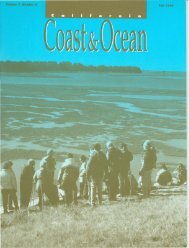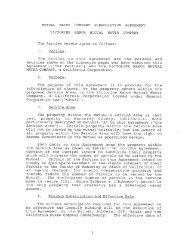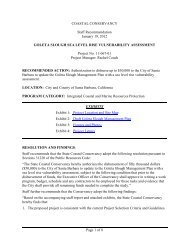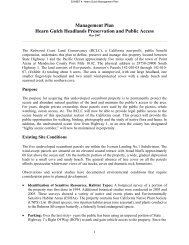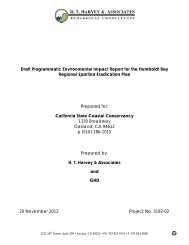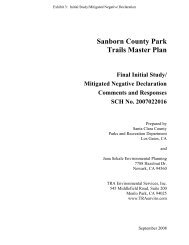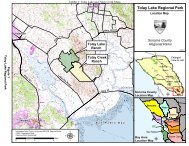Northern San Luis Obispo County Coastal Trail Master Plan
Northern San Luis Obispo County Coastal Trail Master Plan
Northern San Luis Obispo County Coastal Trail Master Plan
You also want an ePaper? Increase the reach of your titles
YUMPU automatically turns print PDFs into web optimized ePapers that Google loves.
<strong>Northern</strong> <strong>San</strong> <strong>Luis</strong> <strong>Obispo</strong> <strong>County</strong> <strong>Coastal</strong> <strong>Trail</strong> <strong>Master</strong> <strong>Plan</strong><br />
The natural habitats in the study area provide suitable conditions for a variety of special-status plant and<br />
animal species. Although numerous occurrences of sensitive species are listed on the CNDDB, many<br />
occurrences are not listed, and many more are likely to be discovered during this and other projects. It is<br />
therefore appropriate to use known habitat types and their potential to contain sensitive species as a basis for<br />
this general overview. For example, herbaceous (grassland) is the most common habitat type present in the<br />
study area, and provides suitable conditions for sensitive plant species, and nesting areas for songbirds and<br />
burrowing owls. Riverine (stream) habitats such as those present at Villa, Pico, <strong>San</strong> Carpoforo, and other<br />
creeks, as well as ponds and wetland areas, have potential to support a variety of sensitive aquatic species,<br />
including steelhead trout, the red-legged frog, and the southwestern pond turtle. The Piedras Blancas<br />
Realignment Final Environmental Impact Report discusses coastal prairie as a sensitive resource that occurs<br />
in this area.<br />
Table 2-5 lists the major habitat types present in the study area, and correlates those habitats with known or<br />
potential occurrences of special-status species. The approximate locations and extent of each habitat type<br />
listed in Table 2-5 is illustrated in the Draft Constraints Maps in the Appendix. Other known or potentially<br />
sensitive biological areas such as marine mammal haul-outs, documented sensitive species occurrences, and<br />
serpentine soil areas, are also included.<br />
Table 2-5: General Constraints and Special-Status Species of the Study Area<br />
Habitat Type General Constraints Special-status Species Associations<br />
Marine/Estuarine/Beaches � Waters of the U.S. (below high tide � Western snowy plover (sandy beaches)<br />
mark) USACE 404 permit required. � Potential “haul-out” areas for elephant<br />
� Waters of the State. RWQCB 401 permit seals (sandy beaches)<br />
required.<br />
� Tidewater goby (estuarine)<br />
� Regulated by CDFG. 1602 Streambed � Steelhead migration (estuarine)<br />
Alteration Agreement required. � Southwestern pond turtle (estuarine)<br />
� Potential habitat for sensitive plant � California red-legged frog (estuarine)<br />
and animal species.<br />
� California sea-blite<br />
� Salt marsh bird’s beak<br />
Riverine<br />
� Waters of the U.S. USACE 404 permit � Steelhead migration corridor (larger<br />
(streams/riparian)<br />
required.<br />
streams)<br />
� Waters of the State. RWQCB 401 permit � Southwestern pond turtle<br />
required.<br />
� California red-legged frog<br />
� Regulated by CDFG. 1602 Streambed � Two-striped garter snake<br />
Alteration Agreement required.<br />
� Potential habitat for sensitive aquatic<br />
animal species.<br />
� Willow flycatcher (nesting)<br />
Freshwater Emergent / � Waters of the U.S. USACE 404 permit � <strong>Northern</strong> harrier (nesting)<br />
Forested Wetland<br />
required.<br />
� Tricolored blackbird (nesting)<br />
(freshwater marsh) � Waters of the State. RWQCB 401 permit � Southwestern pond turtle<br />
required.<br />
� California red-legged frog<br />
� Regulated by CDFG. 1602 Streambed � Two-striped garter snake<br />
Alteration Agreement required.<br />
� Potential habitat for sensitive aquatic<br />
animal species.<br />
� Willow flycatcher (nesting)<br />
Shrub (<strong>Coastal</strong> scrub, � Considered sensitive by CCC.<br />
� Compact cobwebby thistle.<br />
<strong>Coastal</strong> dune scrub, � Potential habitat for sensitive plant � Blochman’s dudleya.<br />
<strong>Northern</strong> coastal bluff<br />
scrub)<br />
and animal species.<br />
� Loggerhead shrike (nesting).<br />
Herbaceous (grasslands) � Contains areas of native grassland. � Compact cobwebby thistle<br />
� Contains areas of coastal prairie. � Jones’s layia<br />
2-20



